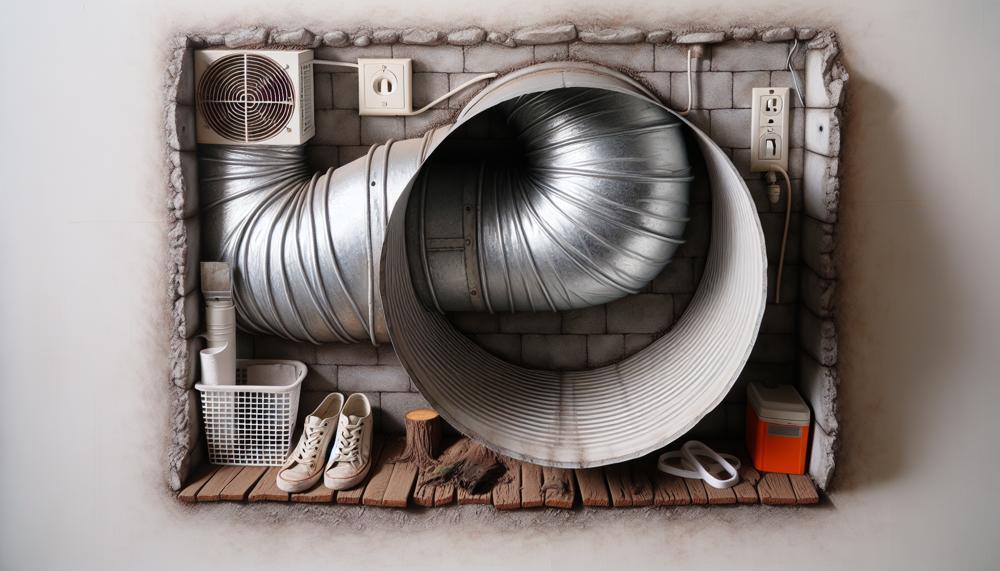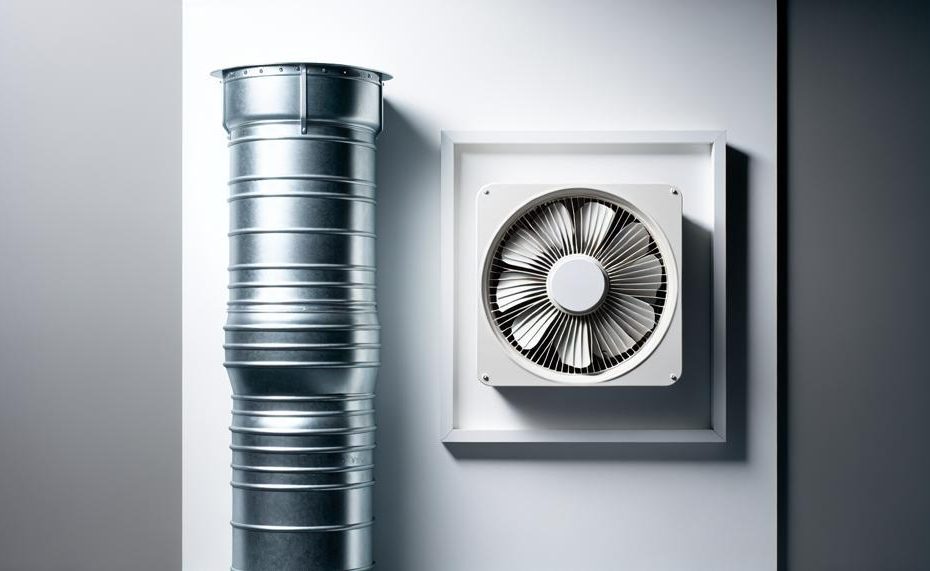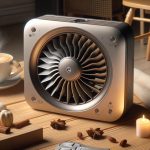Do you dread stepping out of your shower into a stuffy and humid bathroom? Are you searching for an affordable and effective solution to improve the air quality in your bathroom? Yes, you read that right. The same duct that helps dry your clothes can also serve as a powerful bathroom fan.
So, can you use dryer vent duct for bathroom fan?
Yes, you can use dryer vent duct for bathroom fan exhaust. The International Residential Code (IRC) does not have any specific length or diameter requirements for bathroom vents. However, some say that it’s foolish and unsafe to use the dryer vent duct for bathroom fan exhaust because the bathroom is hot, humid, and full of moisture.
Instead, you can use rigid or semi-rigid pipe for both the bathroom fan and dryer, and avoid using backflow preventers. If you have multiple fans running, and one is stronger, the other could be blocked. You can also connect the bathroom fan to the dryer vent and have the dryer vent run straight out an exterior wall.

Keep reading to discover how you can transform your everyday dryer vent duct into a versatile and efficient bathroom fan.
Contents
Clothes Dryer, Bath Fan, and Kitchen Exhaust Systems – Code changes and installation success
In order to comply with current code changes, proper installation of clothes dryer, bath fan, and kitchen exhaust systems entails meeting the requirements for separate venting systems, using non-combustible materials, and ensuring proper termination of the venting system.
Additionally, regular maintenance and cleaning of the venting systems is crucial in preventing potential safety hazards.
Difference between Dryer Vent And Bathroom Vent
The primary contrast between a dryer vent and a bathroom vent is the substance utilized in the duct and their precise functions. Dryer vents are made of metal and are engineered to expel hot air and lint from clothing dryers, while bathroom vents are typically constructed of plastic or metal and are employed to eliminate moisture and smells from bathrooms.
It is essential to utilize the appropriate type of vent for each since utilizing the incorrect type can result in safety hazards, infractions of code, and destruction to your abode.
Dryer Vents:
Dryer vents are vital for suitable ventilation and avoiding fire hazards. They are commonly situated on an external wall, either by means of the roof or side of the house. The primary objective of a dryer vent is to eject hot, damp air from the dryer to the exterior of the dwelling.
This aids in preventing mold growth, diminishing energy costs, and enhancing indoor air quality. Dryer vents also assist in avoiding lint accumulation, which can be a fire hazard if not maintained properly.
Bathroom Vents:
Bathroom vents, also recognized as exhaust fans, serve a disparate function than dryer vents. They are predominantly utilized to eradicate moisture, smells, and bacteria from bathrooms. Bathroom vents are usually positioned on the ceiling or wall and direct to an external vent or attic.
They aid in avoiding mold growth, reducing humidity levels, and improving ventilation in the bathroom. Employing a bathroom vent also helps eliminate odors and keeps your bathroom smelling fresh.
Significance of Utilizing the Appropriate Type of Vent:
It is crucial to utilize the correct type of vent for each specific purpose because using the wrong one can lead to safety hazards and code violations. Dryer vents are made of metal because they need to endure elevated temperatures from the dryer’s hot air.
Using a plastic vent for a dryer can melt or catch fire, resulting in destruction to your abode. On the other hand, using a metal vent for a bathroom fan can cause condensation buildup, resulting in mold growth and potential tripping hazards.
Furthermore, utilizing the wrong vent can lead to code violations, which can result in penalties and delays in selling your home.
What Kind of Pipe Do You Use to Vent a Bathroom Fan?
Selecting the appropriate pipe for venting a bathroom fan is essential, as not all pipes are suitable for this purpose.
The chosen pipe must prevent moisture-related problems and ensure the safety and effectiveness of the ventilation system. Below are several types of pipes that are suitable for bathroom fan venting and their importance.
Wall Venting:
Wall venting involves installing the bathroom fan on the ceiling and connecting it to an exhaust vent that leads to the outside through a wall.
This is a commonly used method, but it can be vulnerable to animals or rain entering through the vent. Proper insulation is crucial to prevent condensation and mold growth.
Roof Venting:
Another popular option is roof venting, where the exhaust vent is mounted on the roof using durable materials like stainless steel.
Proper insulation is necessary in this method as well to prevent moisture buildup and mold growth.
Through-the-Wall Venting:
Through-the-wall venting is a DIY option where the fan is mounted vertically on an exterior wall with a short duct section leading directly outside.
This method requires careful planning and installation to ensure effectiveness and avoid potential hazards.
Soffit Venting:
Soffit venting involves bringing fresh air into the home through vents located under eaves. While this passive system is not ideal for bathroom fan venting, it is important not to interfere with existing systems.
Not Suitable: Attic Venting:
Attic venting, where the exhaust is directed into the attic, should not be used for bathroom fan venting.
This can result in moisture damage, reduced energy efficiency, and health risks due to contaminants re-entering the home.
In conclusion, selecting the appropriate pipe for bathroom fan venting is crucial for proper ventilation and avoiding potential hazards.
Factors such as climate, regulations, and potential hazards must be considered when choosing the right pipe for bathroom fan venting.
Is It Ok to Use Flex Duct for Bathroom Fan?
While it is a viable option, there are some drawbacks to consider based on your individual requirements and preferences. Let’s take a closer look at the advantages and disadvantages of using flexible duct for venting your bathroom fan.
Benefits of using flexible duct:
- Cost-effective: Flexible ducts typically come at a lower price point compared to rigid ducts, making them a popular choice for homeowners on a budget.
- Easy to install: The lightweight and malleable nature of flexible ducts make them ideal for DIY projects. Their flexibility also allows for easy adjustments or repositioning if necessary in the future.
- Versatile: Flexible ducts can be used in various venting configurations, including wall, roof, through-the-wall, and soffit venting.
Drawbacks of using flexible duct:
- Prone to damage: The flexibility of these ducts makes them more susceptible to damage from falling objects or pests. To prevent this, proper support and securing are crucial along the entire length of the duct.
- Reduced airflow efficiency: The numerous turns and bends in flexible air ducts can hinder airflow efficiency, leading to subpar ventilation performance.
- Challenging to clean: Once installed, it is challenging to clean the inside of flexible ducts due to their shape and material.
Can I Use Semi Rigid Duct for Bathroom Fan?
When it comes to installing a bathroom fan, semi-rigid duct is a viable choice, but make sure to confirm with local regulations beforehand.
While rigid duct is generally considered the better option due to its durability and lower resistance, semi-rigid duct can also be used if approved by the municipal. According to the 2014 New York code, both rigid and flexible ducts are allowed in air duct systems, as long as they meet specific requirements and are installed correctly.
One of the main benefits of using semi-rigid duct is its ability to maintain its shape, ensuring efficient airflow and reducing the risk of blockages. This can be particularly important for a bathroom fan that needs to effectively remove moisture from the room. Additionally, semi-rigid ducts are easier to clean and maintain compared to flexible ducts.
However, proper installation and insulation of the chosen duct are crucial in preventing moisture buildup and potential damage.
It is highly recommended to consult a licensed professional roofer in your area to determine which type of duct is approved for use in your location.
Conclusion
In conclusion, while it may seem strange, utilizing a dryer vent duct as a bathroom fan may really be a very affordable and practical way to improve the air quality in your bathroom.
Even though it may not be the most popular method, a dryer vent duct can successfully remove moisture and offensive smells from your bathroom with the right installation and upkeep. This implies that you may lessen the amount of clutter on your walls and ceiling while also saving money on the cost of buying and installing a separate fan.
Just to be clear, there are safety risks and code issues associated with using a dryer vent for bathroom exhaust. It’s crucial to choose the right kind of pipe for venting bathroom fans depending on the temperature and local laws.
Flexible ducts have lower airflow efficiency and are more prone to damage, even though they could seem like a simple and affordable solution. Conversely, semi-rigid ducts are more resilient and provide effective airflow, but correct installation and insulation are necessary to avoid moisture accumulation.
Before deciding to use a dryer vent as a bathroom fan, it is strongly advised to speak with a certified professional roofer in your area to assure the best outcomes. They will possess the knowledge to identify the best choice for your particular area.





